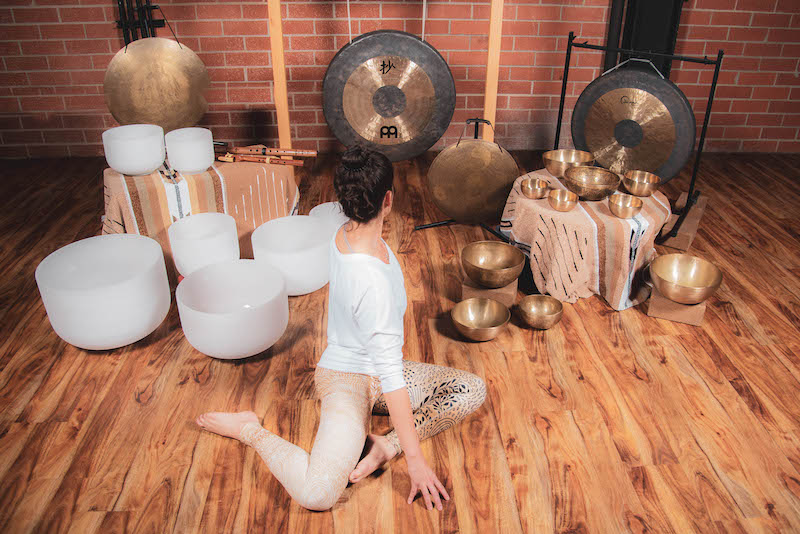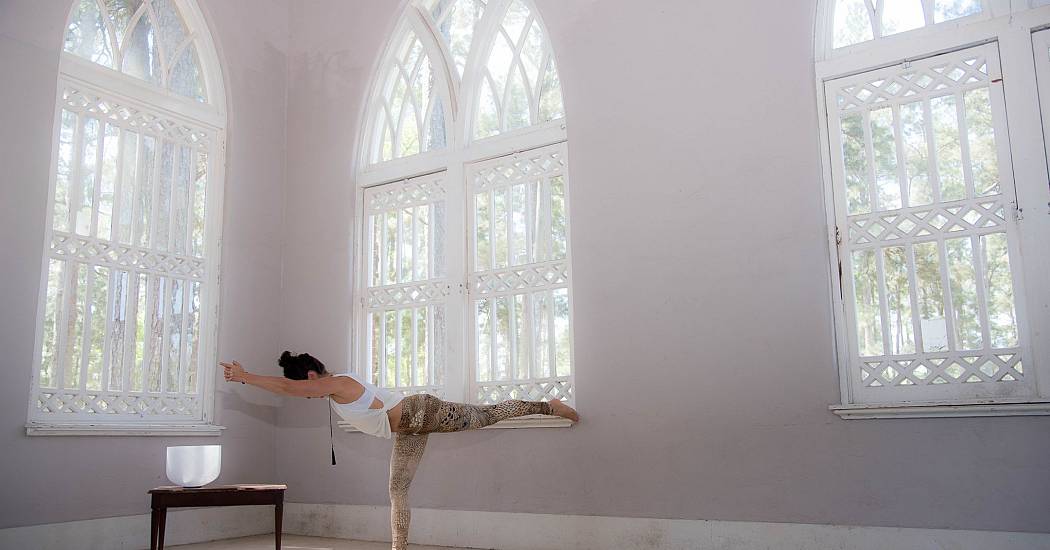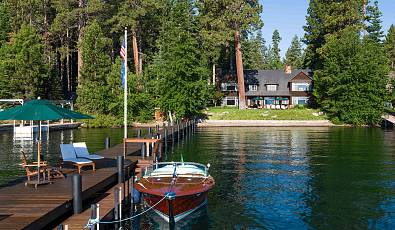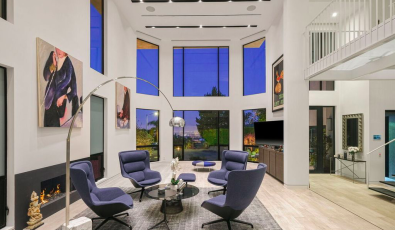Finding hOMe: Cultivating inspiration, community, and resilience today (and everyday) with (Yin) Yoga
Examining yoga and community in the digital space with Jeny Dawson of Zen Soul Balance (ZSB)
Yoga requires a solid foundation: “grounding.” Inspiration grows and blooms from these roots; it is the energetic force that allows one to embody their ideals, create positive change, and explore the limits of human capacity. In this expansion, yoga connects the individual (yoking body, mind, and spirit) to a community (fostering shared human experience). Moreover, at its heart, yoga is practice of presence: Being fully conscious, here and now. Rooted in time and space, yoga’s potential is bound to the moment(s) we create; yet simultaneously possesses the potential to transcend the here and now.
Contemporary Western yoga practice – breath, asanas (i.e., postures or shapes), meditation, etc. – is largely communal, and primarily occurs within the beautiful confines of the yoga studio. However, yoga is also a solitary practice which begins and ends at the individual level, where each practitioner must chart their own path. Accordingly, a dedicated home-practice has always played an essential, complementary role in the yoga journey – with a beauty unique to each practitioner. Recognizing this highlights the challenge(s) and opportunity of creating “space” to practice wholly when physical gathering is not possible (or preferable).
While there are myriad styles of yoga currently practiced at studios around the world, the simplest taxonomic division is between active (Yang) forms of yoga (Vinyasa, Hatha, Ashtanga, etc.); and passive (Yin) approaches (Restorative Yoga, Yoga Nidra, Yin Yoga, etc.). Yang approaches to yoga target, engage, and exercise the various muscles throughout the body through dynamic movement and relatively short static holds, often knitting breath to movement (e.g., creating a “flow” or moving meditation as you see in Vinyasa). Yin approaches seek to soothe, restore, and balance the body through longer static holds, relaxation techniques, and gentle breathwork (e.g., the guided yogic sleep meditation practiced in Yoga Nidra).
Yin Yoga, deriving its name from the style in which it emanates, is a distinct practice characterized by slow, meditative, and functional movement. While it’s a passive form of yoga, it is by no means “easy.” Speaking from personal experience, I’ve found Yin Yoga incredibly beneficial to my overall fitness journey, within and beyond yoga. On its simplest level Yin Yoga is a powerful tool to improve overall mobility, flexibility, and movement; however, the benefits of the practice are many.
In order to better understand the power of Yin Yoga and its relevance in the current period of social distancing – as well as the larger trend of virtual, home yoga practice – I invited Yin specialist, Jeny Dawson of San Diego, CA-based Zen Soul Balance, to share her thoughts. The following is Jeny’s candid perspective on the different styles of yoga; Yin Yoga’s unique capacity to cultivate balance and resilience; best practices for developing a home practice; as well as building community in the digital space:

Matthew: Will you please provide a little bit about your background, as well as your perspective on the various styles of yoga and why you chose to specialize in Yin Yoga?
Jeny: I have been practicing yoga over 20 years – many different styles – and was first introduced to yang forms of yoga…active, dynamic movements targeting muscles…but it was Yin Yoga that helped me learn more about my body than any other exercise I’ve ever done. It helped me to truly understand balance, with regard to physical health. At one point, I thought all exercise was equal and that a combination of cardio, strength training and stretching was what I needed for optimal physical health. It wasn’t until I traveled to Bali, Indonesia for Teacher Training that I had an “awakening” and realized I was missing something…. the “other half.” You’ve heard of yin-yang, right? Half is yin- and the other half is yang – together it’s complete, “whole.” Not all exercise works the body in the same way. There is a difference between “yang muscle engagement” and “yin fascia release.”
In Yin Yoga, practitioners hold postures for long periods – usually 2-7 minutes – allowing time and gravity to do the work. Yin targets the connective tissues – fascia, bones, ligaments, tendons, joints, vertebral discs, etc., by creating shapes. One of the characteristics that sets Yin Yoga apart from other styles of yoga is the functional approach. Every-bone-in-every-body is different, and everyone’s skeleton is unique. This means that every shape that you create with your body will look different than anyone else’s, and that is the beauty of a functional practice. Yin Yoga focuses on functional effects of each posture – how does it feel in your body, rather than how does it look. There is an objective, a “target area” that you intend to therapeutically stretch, massage, compress. etc.. As a teacher, it is my job to encourage students/clients to explore their body and be creative with use of props, etc., ultimately to find their sweet spot – a mild, to moderate level of sensation to achieve an effective stretch.
Yin Yoga forces us to be still. It is a slow and meditative practice. And for some people, this stillness can be excruciatingly painful, and not in a physical way (…..yoga should never be painful by the way – physical or mental!). When holding a posture for a long time (like we do in Yin), we stimulate the energetic channels which can help to move stagnation in transitions. It goes like this…. A posture is released, subtle energy shifts occur (sometimes noticeable, sometimes not) and we enter the “rebound” for moments of stillness, according to the Grilley model – and then yang activations to move the energy. Quite often when we are dealing with unresolved emotions like sadness or anger, we tend to suppress or find ways to occupy our minds to avoid confronting our emotional discomforts. Unfortunately, what happens over time, is our well-buried emotions begin to surface and manifest in physical forms such as body pains, headaches, insomnia, and indigestion; or the stagnation can transform into negative emotions like jealousy, frustration, indecisiveness, paranoia, and depression. Though it may sound daunting at first (yes it can get messy diving inwards), but once the layers are pealed back and the “baggage” is gone, there is an emotional and energic release that creates internal space for healing. I can speak for it myself, I remember like it was yesterday the first time it happened to me. Sitting at home on my living room floor in a reclining twist and bam - out of nowhere (in a good state of mind, I thought…..) the tears started flowing, emotions were scattered and thoughts were flooding in. I won’t go into much detail other than it was an unexpectedly profound practice that ended with a huge sigh of relief and a lot of tears.
With regard to my formal yoga education, I have gone through extensive Yin trainings and have researched the science behind Yin Yoga over the years. I owe a debt of gratitude to my teachers, Paul Grilley – the founder of Yin Yoga as we know it today – and Joe Barnett, a senior Yin Yoga trainer who has apprenticed for two decades under Paul Grilley and has spent 10 years connecting to thousands of aspiring yoga teachers – he travels internationally to offer workshops and trainings under the school name of “Yin Variations,” the program that stays true to the most updated Grilley Method of Yin. I’ve had the honor and privilege not only to train and study under both of these amazing Master Teachers, but also to assist Joe Barnett in teacher trainings. Most recently I have partnered with Joe and will be offering an extension of his Yin Variations trainings through ZSB to reach a broader community.
Matthew: If the solitary home practice is complementary to the communal experience, Sound complements the Yin practice, right?
Jeny: Absolutely. Add Sound Healing – crystal singing bowls, chimes, gongs, and other musical instruments – to compliment the shapes, and wow…it is a profound experience that is hard to explain. A few years ago I started experimenting (in my own body) in Yin postures using vibrations from a variety of instruments. With the help of ZSB Sound Practitioner, Mark Carter, we discovered that different sounds (pitch, tone, vibration, etc..) land in the body differently. For example, some sounds in certain poses, targeting certain regions in the body help you to relax (and soften physically/mentally), whereas other sounds have the opposite effect. As I said, it was exploratory at first, and then after we started introducing this into my classes publicly and receiving feedback it was amazing! Students regularly approached us after class with emotion – hugs, flowing tears, laugher, gratitude, profound stories, etc.. The feedback was enough to inspire us to go further and start researching and training professionally. Needless to say, we opened a can of worms! What we have since learned is the science behind it, and that is fascinating!
Speaking of the power of sound – we partner with Scripps Shiley Sports and Fitness Center at Scripps Integrative Medicine in La Jolla to offer weekly Yoga & Sound Therapy classes to cancer survivors, as well as Sound Bath sessions to the general public (Link event page). To learn more about the difference between Sound Healing, Sound Therapy and Sound Meditation read this. People are catching on to the benefits that Yin Yoga, Restorative Yoga and Sound Healing have to offer, and business for ZSB is growing. Most recently ZSB has welcomed an additional member to the team, Sound Practitioner/Reiki Master, Bruce Reeves.
Matthew: As someone who was drawn to yoga in large part for the sense of community – I have several regular fitness practices I love, but are essentially solitary – what is your perspective on building and maintaining a sense of community in the digital space?
Jeny: I will be honest and say that when social distancing first started and my primary studio where I teach in-person closed, I was hesitant to start practicing online, personally – as well as teaching. However, to my surprise, after taking my first class I realized how much I needed it. Yes, of course it was a different experience than practicing at the studio, but I still felt amazing afterwards. Following that experience, I started teaching live classes and filming recorded videos…building a “ZSB Library” of Yin Yoga, Restorative Yoga and Sound Healing sessions because my students were requesting it. The outpouring of gratitude has inspired me to keep going! I say all of this for those who are struggling to find the motivation or even skeptical about starting an online yoga practice or trying a sound bath session. If that’s the case for you, just know that you’re not alone… I encourage you to at least give it a chance. Yes, it is an adjustment but one well worth it.
It is a learning curve for all of us – even for me as an experienced Yin Yoga Teacher & Trainer. However, what has always been top priority for my classes, events and trainings is to create a space where everyone feels welcome, supported, and safe – no matter where you are on your journey. Some suggestions I like to give for those new to practicing at home and in the virtual space is to create a safe-comfortable area somewhere away from distractions. If you have the luxury of dimming the lights; using essential oils; lighting incense or candles; and/or playing some relaxing music…those could be some nice options to consider. I create musical playlists for my classes and share with students who enjoy it.
Prepare a space where you can relax and decompress, whatever that looks like for you. Think of your online practice as an opportunity to carve out space for self-care. Yin Yoga brings balance into chaotic times by grounding us promoting peace and calm. Saying that, I have been very intentional with the spaces where I film online classes with the hope of setting the tone for my viewers. Sometimes I film from my home meditation area where it feels safe and sacred. Other times I use a vacant studio, my home away from home. A beautiful, vibrant studio in Texas – Fly & Love Yoga & Cat Lounge offered me their space for filming. This is not your average yoga studio; it is also a foster home for rescue cats up for adoption. It has been so uplifting to practice yoga and film online classes with these cats and their sweet, loving energy. It is truly a gift! My home studio in California continues to support me and ZSB, Riffs Yoga Studios in Bird Rock – a gem in San Diego. If you have never been there before it is very special – a cozy outdoor studio with ocean breeze, lush greenery and amazing community. As we practice social distancing, we are safely filming classes to continue sharing the beautiful energy online from both locations (also in Ocean Beach).
Also, the beauty of Live Zoom Group Classes is that you have the option of joining in community by chatting with others before or after class on video (or throughout in the chat box); OR staying completely private with your camera and microphone turned off.
Adapting to the present reality (and expanding its reach) ZSB currently offers several remote options to practice: livestreamed classes through Zoom; partnering with local studios; on-demand recorded classes filmed in engaging settings; professional development and trainings; sound baths and special events; as well as private, tailored offerings for individuals and/or small groups. (Links to be included)
The core of meditation – in whatever form it takes – is (singular) focus; expanding one’s perspective by simplifying…identifying what is truly important, and eliminating distractions. Mediation and its vehicle, Yin Yoga, therefore, are tools to build resilience in uncertain times – and every day. With these resources available wherever you are, what’s stopping you from starting (or expanding) your yoga practice and, possibly, finding hOMe?
Images courtesy of MC Photography.
*This is a guest blog post by Matthew Yunker at Hunter & Maddox Real Estate. If you have questions, please feel free to contact Matthew here.
- Topics:
- Voice from the Street
- Sustainable Living


